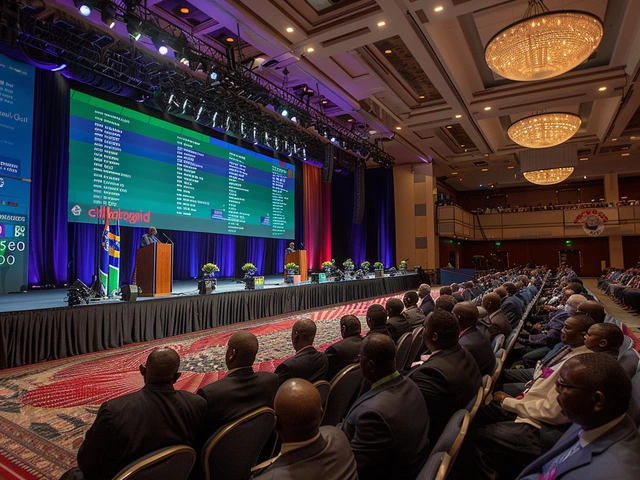The South African Rand Faces Turmoil in Tumultuous Markets
The South African Rand is experiencing a significant slump as it struggles to navigate through an intricate web of global economic uncertainties and elevated US Treasury yields. On Tuesday, November 12, 2024, the Rand further extended its losses, hitting R18.37 against the dollar, marking its lowest point in almost two weeks. This depreciation is part of a broader trend affecting emerging market currencies, many of which are reeling under the pressures of a volatile global economic landscape.
The decline in the Rand, which saw a 0.6% drop, has mirrored the struggles of other emerging market currencies such as the Turkish lira and Brazilian real. This tumult in emerging markets is symptomatic of investors’ growing risk aversion. As they recalibrate their portfolios, many are opting to shift towards more stable assets, steering clear of the perceived volatility in emerging markets. The MSCI Emerging Markets Currency Index, which serves as a benchmark for these currencies, saw a noticeable decline of 0.4%, underscoring the widespread sentiment of caution among global investors.
Global Influences Weigh Heavy
Globally, the economic environment has been fraught with challenges. Rising US Treasury yields, notably the yield on the 10-year note which has peaked at 4.93%—a level unseen in nearly two decades—are particularly noteworthy. For investors, this translates to enhanced returns on American assets, drawing funds away from emerging markets that become less competitive in the face of such robust yields. The allure of US bonds becomes even more pronounced when juxtaposed with the vulnerabilities perceived in developing economies.
In South Africa, the economic outlook is marred by uncertainty. The country's economic growth has been sluggish, still grappling with the fallout from the COVID-19 pandemic’s far-reaching impacts. The South African Reserve Bank faces a delicate balancing act in its upcoming policy meeting. While the inclination might be to maintain current interest rates to support a fragile economy, persistent inflation concerns could necessitate a rate hike—a move that could prove contentious in the current climate.
Commodity Prices and Local Challenges
The drop in commodity prices, particularly gold, which fell by 1.2% to $1,934.66 an ounce, exacerbates the Rand’s volatility. Given that gold remains a cornerstone of South Africa's export economy, a drop in its price reverberates through the Rand’s valuation, adding another layer of strain to an already beleaguered currency. This decline in commodity prices is compounded by thin trading volumes, a condition that amplifies currency volatility as fewer market participants translate to greater price sensitivity to trades.
The backdrop of these challenges is a sentiment of caution overshadowing the financial markets. Many investors are strategically holding back, opting to wait for the release of US inflation data before committing more significantly to market positions. This reticence reflects the broader uncertainty that dominates, with analysts predicting continued pressure on the Rand in the short term. Some even speculate that should global economic anxieties persist, the Rand could weaken further, possibly reaching R19 against the dollar.
The Road Ahead
Looking ahead, the Rand’s trajectory remains precarious. As it navigates domestic challenges and the external pressures of a demanding global economic environment, market participants and policymakers will need to remain agile. The interplay of rising US interest rates, fluctuating commodity prices, and South Africa’s economic policies will be crucial factors influencing the Rand’s future stability.
While emerging markets often present growth opportunities, they also come with heightened risks, especially in tumultuous times like these. The story of the South African Rand serves as a poignant reminder of the interconnected nature of global financial markets, where domestic events intertwine with international trends, shaping the economic fortunes of nations.





Comments
While the Rand’s slide reflects broader emerging‑market pressure, it’s worth noting that South Africa’s fiscal stance remains a key lever. The SARB’s next policy decision could either anchor expectations or add volatility, depending on whether they tilt toward a rate hike. Investors typically monitor inflation trends alongside commodity‑price movements; a dip in gold prices removes a natural hedge for the currency. Maintaining a balanced portfolio with diversified exposure can help mitigate the short‑term turbulence. Keeping an eye on US Treasury yields is also prudent, as they continue to attract capital away from riskier assets.
Man, the Rand’s been on a rollercoaster – roudy like a wild ride 😅. US bond yields are pulling the rope, and our gold price dip just adds more drama. It’s kinda like watching a telenovela where the hero (our economy) keeps tripping over the same old plot twists. Hope the SARB finds a happy ending soon!
It’s obvious the Rand is being pummeled by a perfect storm of external and internal factors. First, the surge in US Treasury yields offers a risk‑free alternative that simply outshines any emerging‑market asset. Second, the dip in gold prices robs South Africa of its traditional export cushion. Third, domestic growth remains anemic, making the currency vulnerable to any negative shock. Fourth, the SARB’s indecision on rates signals a lack of policy conviction. Fifth, investors are already jittery after the recent turbulence in the Turkish lira and Brazilian real. Sixth, thin trading volumes amplify each trade’s impact on the Rand’s price. Seventh, the global risk‑off sentiment is not a fleeting mood but a sustained trend. Eighth, the MSCI emerging‑markets currency index’s decline confirms the broader capital flight. Ninth, South Africa’s fiscal deficits add another layer of concern. Tenth, the political landscape continues to generate uncertainty. Eleventh, even minor shifts in US inflation data can trigger massive reallocations. Twelfth, the market’s forward‑looking nature means any hint of weakness is immediately priced in. Thirteenth, speculative positioning is likely to exacerbate volatility. Fourteenth, the combination of these dynamics makes a further weakening to the R19 level highly plausible. Fifteenth, without decisive action from policymakers, the Rand’s outlook remains bleak.
The Rand depreciation aligns with a risk‑off regime, wherein elevated 10‑yr yields elevate the opportunity cost of emerging‑market exposure, precipitating capital outflows and depreciative pressure.
Looks like the Rand might keep sliding unless there’s a policy pivot 😐.
Stay positive 🌟 Rand will bounce back soon 🚀